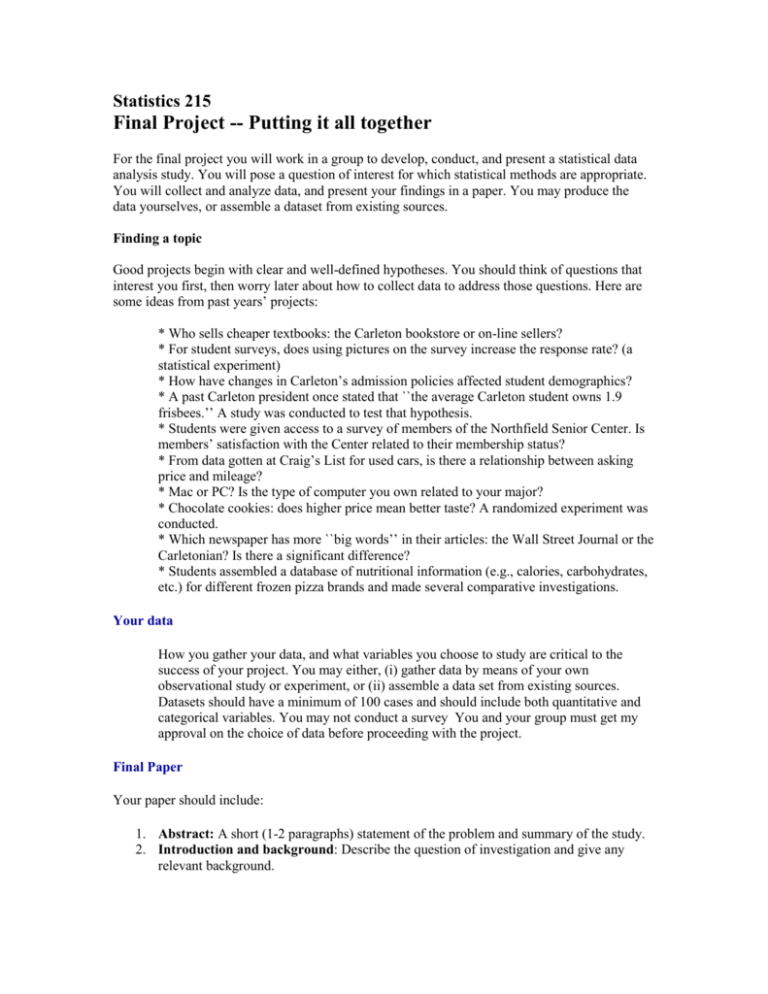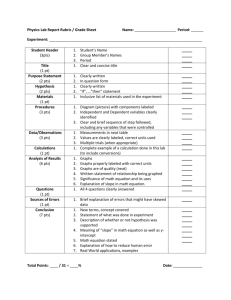Statistics 215 Guidelines for Final Term Project Spring 2003
advertisement

Statistics 215 Final Project -- Putting it all together For the final project you will work in a group to develop, conduct, and present a statistical data analysis study. You will pose a question of interest for which statistical methods are appropriate. You will collect and analyze data, and present your findings in a paper. You may produce the data yourselves, or assemble a dataset from existing sources. Finding a topic Good projects begin with clear and well-defined hypotheses. You should think of questions that interest you first, then worry later about how to collect data to address those questions. Here are some ideas from past years’ projects: * Who sells cheaper textbooks: the Carleton bookstore or on-line sellers? * For student surveys, does using pictures on the survey increase the response rate? (a statistical experiment) * How have changes in Carleton’s admission policies affected student demographics? * A past Carleton president once stated that ``the average Carleton student owns 1.9 frisbees.’’ A study was conducted to test that hypothesis. * Students were given access to a survey of members of the Northfield Senior Center. Is members’ satisfaction with the Center related to their membership status? * From data gotten at Craig’s List for used cars, is there a relationship between asking price and mileage? * Mac or PC? Is the type of computer you own related to your major? * Chocolate cookies: does higher price mean better taste? A randomized experiment was conducted. * Which newspaper has more ``big words’’ in their articles: the Wall Street Journal or the Carletonian? Is there a significant difference? * Students assembled a database of nutritional information (e.g., calories, carbohydrates, etc.) for different frozen pizza brands and made several comparative investigations. Your data How you gather your data, and what variables you choose to study are critical to the success of your project. You may either, (i) gather data by means of your own observational study or experiment, or (ii) assemble a data set from existing sources. Datasets should have a minimum of 100 cases and should include both quantitative and categorical variables. You may not conduct a survey You and your group must get my approval on the choice of data before proceeding with the project. Final Paper Your paper should include: 1. Abstract: A short (1-2 paragraphs) statement of the problem and summary of the study. 2. Introduction and background: Describe the question of investigation and give any relevant background. 3. Data collection: Describe the data. How did you collect the data? Define your observational units, variables, population and parameter(s). If you obtained a sample, describe the sampling method you used. If you designed a survey, are there any potential wording issues? Did you “field-test” the questions first? What was the response rate? If you conducted an experiment describe the design. If you gathered data from another source, was the data based on an experiment or observational study? Give lots of detail. Include the actual data you collected, or access to it, in an appendix. 4. Analysis: How did you use inferential methods to tackle your problem? What types of hypothesis tests did you use, if any? How about confidence intervals? Make sure to discuss not only the methods but the assumptions underlying the use of those methods. If you used bootstrapping or randomization methods, explain these carefully. Include the technical details of calculations in an appendix, as necessary. If you are using statistical methods we learned in class, you do not have to re-explain them. Use graphs and tables to describe and illustrate your findings. Include computer output as needed and as appropriate. Any computer output needs to be explained. All graphs, tables, charts, output, and figures should be labeled well and referenced in the body of your text. 5. Results and conclusions: Give your results in a thoughtful and measured way. Answer your initial question of interest. Present relevant descriptive statistics. Include tables or graphs that support your analysis. 6. Discussion: What implications do your results have for the population you investigated? What types of biases might exist? How confident are you in your results? Did anything go wrong in the course of the study? If you had to do it all over again what would you do differently? 7. Appendices as appropriate. Assessment The final project grade will be based on the following scoring rubric: 1. 2. 3. 4. 5. 6. 7. 8. Did you tackle an interesting and challenging question for which statistical methods are appropriate and relevant? (10 pts) Did you meet all project deadlines? Does the paper meet format requirements? (10 pts) Is the writing clear and is it easy for the reader to understand what you did? Is the paper well-written and proofread? (10 pts) Are the data collection methods sound and appropriate for the problem? (15 pts) Is there correct use of statistical terminology? Is there good and appropriate use of graphs, charts and computer output? (20 pts) Did you use appropriate statistical methods and did you use them correctly? Is the statistical analysis sound? (20 pts) Are the results and conclusions justified and meaningful? Did you answer the question of investigation? Is there a measured and thoughtful concluding discussion and assessment? (10 pts) Does the overall project show originality and creativity? (5 pts) Personal assessment After the paper is done, each student should e-mail me a confidential, individual assessment of how the project went and how they and their partner contributed to the effort.





